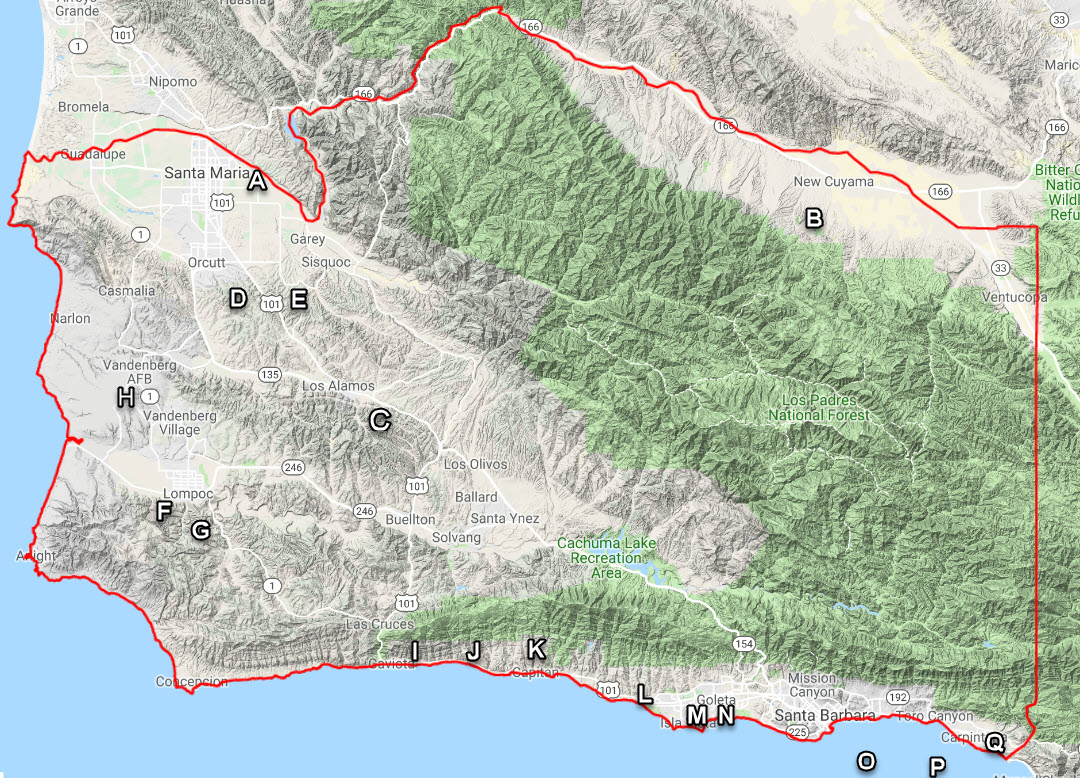Title V permits, also known as Part 70 Federal Operating Permits, are federal operating permits for facilities in our county that have the potential to emit large amounts of air pollution. These permits are issued locally by the District under Title V of the federal Clean Air Act amendments of 1990.
Sources in Santa Barbara County with Title V operating permits
Check recent listings on the public notices page to see if there are any draft Title V permits currently open for public review.
Sources in Santa Barbara County with Title V Operating Permits

A City of Santa Maria Landfill/J&A Santa Maria
B South Cuyama Oil Fields and Gas Plant
C Barham Ranch
D Orcutt Hill Oil Fields
E South Cat Canyon Oil Fields
F Lompoc Sanitary Landfill
G Imerys Minerals California Lompoc Plant
H Vandenberg Air Force Base
I The Point Arguello Project Offshore Platforms and Gaviota Oil Heating Facility
J Tajiguas Landfill/Fortistar Methane Group
K Santa Ynez Unit Project Offshore Platforms and Onshore Facility
L South Ellwood Field
M University of California, Santa Barbara
N La Goleta Natural Gas Storage Facility
O Platforms A, B, C, Henry, and Hillhouse
P Platforms Hogan and Houchin
Q Carpinteria Gas Plant
Frequently Asked Questions
Q1: Don’t these facilities already have local permits from the District?
Yes. The District has streamlined its permitting process to issue a combined local and federal operating permit. This avoids duplicated documents, and reduces costs for applicants.
Q2: What are the benefits of the Title V/Part 70 Program?
There are three principal benefits:
- Increased accountability to the public. The public is invited to comment on these permits, and all public comments are considered before permits are issued. Once issued, the permits are enforceable by the public.

- Enhanced monitoring, recordkeeping, and reporting requirements. These requirements promote ongoing internal vigilance by industry operators, and ensure that facilities are subject to consistent oversight by the U.S. Environmental Protection Agency.

- Emission reductions. Some potential Title V sources have reduced emissions to get below the threshold pollution levels so they will not be required to obtain these federal permits.
Q3: How do we determine which facilities have to obtain a Title V permit?
A facility becomes subject to this federal program based on its potential to emit air pollution, which is determined by the physical and operational design of the facility. Santa Barbara County is classified a federal ozone attainment area, so the threshold for a Part 70 permit in our county is 100 tons per year potential to emit of any single pollutant.
Q4: What kinds of things do permits require?
Permits describe how a facility must comply with air pollution rules. For example, a permit might require that a facility install certain kinds of pollution control devices, or might impose limits on a facility’s operating times or total emissions. Monitoring and recordkeeping requirements are important components of Title V permits. Permits usually require facilities to keep track of their emissions and make regular reports.
Q5: Can the public participate in the process?
Yes. Public participation is one of the most important features of the Title V process.
During the official public comment period, any member of the public may review a proposed Title V permit and comment on it. Members of the public may also request that the District hold a public hearing for discussion of any permitting issues.
Comments are most effective when they make specific suggestions for changes to the permit, explain why these changes are needed, and refer to applicable rules and regulations.
Q6: Can the public be involved after the permit is issued?
Yes. Facilities are required to fill out a compliance certification every year, and a compliance verification report every six months. The public may review these to make sure facilities are meeting their permit requirements.
If citizens are concerned that the source is not complying with the Title V permit, their first option is to call on the District to enforce the permit. If they are still not satisfied, then they can call on the U.S. Environmental Protection Agency to enforce the permit. Title V permits can also be enforced by citizens in federal court.
Q7: Is an application required to transfer ownership or change the Responsible Official for my Part 70 Source?
Pursuant to the requirements of Rule 1304.D.2 and the definition of “Administrative Permit Amendment” in Rule 1301.C, a Part 70 administrative permit amendment is required to authorize the transfer of ownership or change the Responsible Official for a Part 70 source. The administrative permit amendment application should include the following forms: Form-01, Form 1302-A1, Form 1302-A2 and Form 1302-M.
For more information . . .
- Download a copy of Regulation XIII: Part 70 Operating Permit Program
- Download Title V Operating Permit and Reporting Forms
- Go to the California Air Resources Board web site for an Overview of Title V Permit Program Requirements
- Go the the U.S. Environmental Protection Agency (USEPA) website Operating Permits Issued under Title V of the Clean Air Act.
- Go the the USEPA Region IX website CAA Permitting in EPA’s Pacific Southwest Region.
For more information, contact us via email at [email protected].

